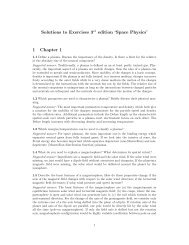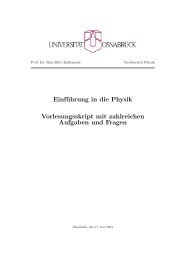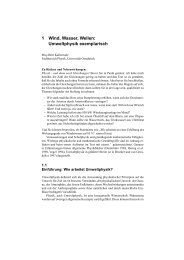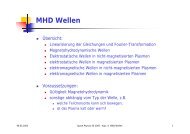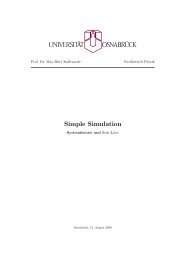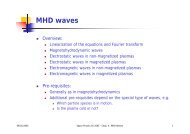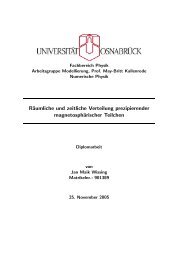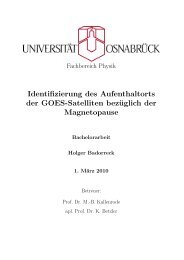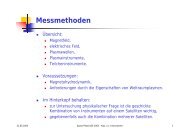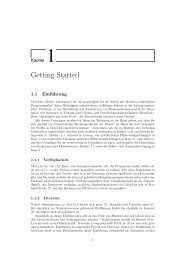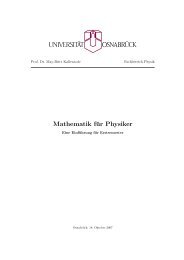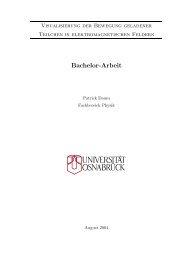- Seite 1 und 2:
Prof. Dr. May-Britt Kallenrode Fach
- Seite 3 und 4:
Inhaltsverzeichnis 1 Einführung 5
- Seite 5 und 6:
INHALTSVERZEICHNIS 3 5.4.1 Das Plan
- Seite 7 und 8:
Kapitel 1 Einführung Once a photog
- Seite 9 und 10:
Abbildung 1.3: In den typischen Ill
- Seite 11 und 12:
1.1. HISTORISCHES 9 Abbildung 1.5:
- Seite 13 und 14:
1.1. HISTORISCHES 11 Abbildung 1.8:
- Seite 15 und 16:
1.1. HISTORISCHES 13 Bestandteil di
- Seite 17 und 18:
1.2. ZIELE DER ERDFERNERKUNDUNG 15
- Seite 19 und 20:
1.3. EIN BEISPIEL - DEFINITION DER
- Seite 21 und 22:
1.3. EIN BEISPIEL - DEFINITION DER
- Seite 23 und 24:
1.4. AUFBAU DER VORLESUNG 21 • di
- Seite 25 und 26:
2.1. HISTORISCHES: EIN APFEL FÄLLT
- Seite 27 und 28:
2.2. PHYSIKALISCHE GRUNDLAGEN 25 2.
- Seite 29 und 30:
2.2. PHYSIKALISCHE GRUNDLAGEN 27 Fl
- Seite 31 und 32:
2.2. PHYSIKALISCHE GRUNDLAGEN 29 En
- Seite 33 und 34:
2.2. PHYSIKALISCHE GRUNDLAGEN 31 §
- Seite 35 und 36:
2.3. BAHNSTÖRUNGEN 33 wir Korrektu
- Seite 37 und 38:
2.3. BAHNSTÖRUNGEN 35 Abbildung 2.
- Seite 39 und 40:
2.3. BAHNSTÖRUNGEN 37 2.3.2 Reibun
- Seite 41 und 42:
2.3. BAHNSTÖRUNGEN 39 Abbildung 2.
- Seite 43 und 44:
2.3. BAHNSTÖRUNGEN 41 Abbildung 2.
- Seite 45 und 46:
2.3. BAHNSTÖRUNGEN 43 Abbildung 2.
- Seite 47 und 48:
2.4. TYPISCHE BAHNEN VON ERDGEBUNDE
- Seite 49 und 50:
2.4. TYPISCHE BAHNEN VON ERDGEBUNDE
- Seite 51 und 52:
2.4. TYPISCHE BAHNEN VON ERDGEBUNDE
- Seite 53 und 54:
2.4. TYPISCHE BAHNEN VON ERDGEBUNDE
- Seite 55 und 56:
2.4. TYPISCHE BAHNEN VON ERDGEBUNDE
- Seite 57 und 58:
2.5. STABILISIERUNG DES SATELLITEN
- Seite 59 und 60:
2.6. EINBRINGEN DES SATELLITEN IN S
- Seite 61 und 62:
2.6. EINBRINGEN DES SATELLITEN IN S
- Seite 63 und 64:
2.6. EINBRINGEN DES SATELLITEN IN S
- Seite 65 und 66:
2.6. EINBRINGEN DES SATELLITEN IN S
- Seite 67 und 68:
2.6. EINBRINGEN DES SATELLITEN IN S
- Seite 69 und 70:
2.6. EINBRINGEN DES SATELLITEN IN S
- Seite 71 und 72:
2.7. ERGÄNZUNG: SPEZIELLE BAHNEN 6
- Seite 73 und 74:
2.7. ERGÄNZUNG: SPEZIELLE BAHNEN 7
- Seite 75 und 76:
2.7. ERGÄNZUNG: SPEZIELLE BAHNEN 7
- Seite 77 und 78:
2.7. ERGÄNZUNG: SPEZIELLE BAHNEN 7
- Seite 79 und 80:
2.7. ERGÄNZUNG: SPEZIELLE BAHNEN 7
- Seite 81 und 82:
2.7. ERGÄNZUNG: SPEZIELLE BAHNEN 7
- Seite 83 und 84:
2.7. ERGÄNZUNG: SPEZIELLE BAHNEN 8
- Seite 85 und 86:
3.1. GRUNDLAGEN 83 Abbildung 3.1: D
- Seite 87 und 88:
3.1. GRUNDLAGEN 85 Höhe, ab ca. 25
- Seite 89 und 90:
3.1. GRUNDLAGEN 87 Abbildung 3.4: S
- Seite 91 und 92:
3.1. GRUNDLAGEN 89 Abbildung 3.7: S
- Seite 93 und 94:
3.1. GRUNDLAGEN 91 mit weitem Energ
- Seite 95 und 96:
3.2. PASSIVE INSTRUMENTE IM SICHTBA
- Seite 97 und 98:
3.2. PASSIVE INSTRUMENTE IM SICHTBA
- Seite 99 und 100:
3.2. PASSIVE INSTRUMENTE IM SICHTBA
- Seite 101 und 102:
3.2. PASSIVE INSTRUMENTE IM SICHTBA
- Seite 103 und 104:
3.2. PASSIVE INSTRUMENTE IM SICHTBA
- Seite 105 und 106:
3.2. PASSIVE INSTRUMENTE IM SICHTBA
- Seite 107 und 108:
3.2. PASSIVE INSTRUMENTE IM SICHTBA
- Seite 109 und 110:
3.2. PASSIVE INSTRUMENTE IM SICHTBA
- Seite 111 und 112:
3.2. PASSIVE INSTRUMENTE IM SICHTBA
- Seite 113 und 114:
3.2. PASSIVE INSTRUMENTE IM SICHTBA
- Seite 115 und 116:
3.2. PASSIVE INSTRUMENTE IM SICHTBA
- Seite 117 und 118:
3.2. PASSIVE INSTRUMENTE IM SICHTBA
- Seite 119 und 120:
3.2. PASSIVE INSTRUMENTE IM SICHTBA
- Seite 121 und 122:
3.2. PASSIVE INSTRUMENTE IM SICHTBA
- Seite 123 und 124:
3.2. PASSIVE INSTRUMENTE IM SICHTBA
- Seite 125 und 126:
3.2. PASSIVE INSTRUMENTE IM SICHTBA
- Seite 127 und 128:
3.2. PASSIVE INSTRUMENTE IM SICHTBA
- Seite 129 und 130:
3.2. PASSIVE INSTRUMENTE IM SICHTBA
- Seite 131 und 132:
3.2. PASSIVE INSTRUMENTE IM SICHTBA
- Seite 133 und 134:
3.3. PASSIVE INSTRUMENTE IM NICHT-S
- Seite 135 und 136:
3.3. PASSIVE INSTRUMENTE IM NICHT-S
- Seite 137 und 138:
3.3. PASSIVE INSTRUMENTE IM NICHT-S
- Seite 139 und 140:
3.3. PASSIVE INSTRUMENTE IM NICHT-S
- Seite 141 und 142:
3.3. PASSIVE INSTRUMENTE IM NICHT-S
- Seite 143 und 144:
3.3. PASSIVE INSTRUMENTE IM NICHT-S
- Seite 145 und 146:
3.3. PASSIVE INSTRUMENTE IM NICHT-S
- Seite 147 und 148:
3.3. PASSIVE INSTRUMENTE IM NICHT-S
- Seite 149 und 150:
3.4. AKTIVE INSTRUMENTE 147 Abbildu
- Seite 151 und 152:
3.4. AKTIVE INSTRUMENTE 149 Abbildu
- Seite 153 und 154:
3.4. AKTIVE INSTRUMENTE 151 Abbildu
- Seite 155 und 156:
3.4. AKTIVE INSTRUMENTE 153 Tabelle
- Seite 157 und 158:
3.4. AKTIVE INSTRUMENTE 155 Abbildu
- Seite 159 und 160:
3.4. AKTIVE INSTRUMENTE 157 Tabelle
- Seite 161 und 162:
3.5. SOUNDER 159 3.5 Sounder Abbild
- Seite 163 und 164:
3.5. SOUNDER 161 Abbildung 3.81: Da
- Seite 165 und 166:
3.5. SOUNDER 163 CO2 [ppm] CH4 [ppm
- Seite 167 und 168:
3.5. SOUNDER 165 eines oder mehrere
- Seite 169 und 170:
3.5. SOUNDER 167 • die Dynamik de
- Seite 171 und 172:
3.6. WUNSCHZETTEL DER 1990ER: MISSI
- Seite 173 und 174:
3.7. ANWENDUNGSBEISPIELE 171 Abbild
- Seite 175 und 176:
3.7. ANWENDUNGSBEISPIELE 173 Abbild
- Seite 177 und 178:
3.7. ANWENDUNGSBEISPIELE 175 Abbild
- Seite 179 und 180:
3.7. ANWENDUNGSBEISPIELE 177 Waldbr
- Seite 181 und 182:
3.7. ANWENDUNGSBEISPIELE 179 Abbild
- Seite 183 und 184:
3.7. ANWENDUNGSBEISPIELE 181 Abbild
- Seite 185 und 186:
3.7. ANWENDUNGSBEISPIELE 183 Abbild
- Seite 187 und 188:
3.7. ANWENDUNGSBEISPIELE 185 Abbild
- Seite 189 und 190:
3.7. ANWENDUNGSBEISPIELE 187 Abbild
- Seite 191 und 192:
3.7. ANWENDUNGSBEISPIELE 189 Abbild
- Seite 193 und 194:
3.7. ANWENDUNGSBEISPIELE 191 Abbild
- Seite 195 und 196:
3.7. ANWENDUNGSBEISPIELE 193 u.a. e
- Seite 197 und 198:
3.7. ANWENDUNGSBEISPIELE 195 Frage
- Seite 199 und 200:
3.7. ANWENDUNGSBEISPIELE 197 0.972.
- Seite 201 und 202:
4.1. DER KLASSISCHE GEOGRAPH: LANDS
- Seite 203 und 204:
4.2. EIN METEOROLOGE: METEOSAT 201
- Seite 205 und 206:
4.3. EIN TIEFER GELEGTER METEOROLOG
- Seite 207 und 208:
4.4. DER GENERALIST FÜR UMWELTFRAG
- Seite 209 und 210:
4.4. DER GENERALIST FÜR UMWELTFRAG
- Seite 211 und 212:
4.5. SMALL IS BEAUTIFUL: CHAMP UND
- Seite 213 und 214:
4.7. LOST AND FOUND: GPS-NAVSTAR 21
- Seite 215 und 216:
4.8. MISSION TO PLANET EARTH 213 im
- Seite 217 und 218:
4.8. MISSION TO PLANET EARTH 215 Bi
- Seite 219 und 220:
4.8. MISSION TO PLANET EARTH 217 Ab
- Seite 221 und 222:
4.8. MISSION TO PLANET EARTH 219 Aq
- Seite 223 und 224: 4.8. MISSION TO PLANET EARTH 221 §
- Seite 225 und 226: 5.1. DAS NAHE ERDUMFELD 223 5.1.1 D
- Seite 227 und 228: 5.1. DAS NAHE ERDUMFELD 225 Abbildu
- Seite 229 und 230: 5.1. DAS NAHE ERDUMFELD 227 Abbildu
- Seite 231 und 232: 5.1. DAS NAHE ERDUMFELD 229 Abbildu
- Seite 233 und 234: 5.1. DAS NAHE ERDUMFELD 231 Abbildu
- Seite 235 und 236: 5.1. DAS NAHE ERDUMFELD 233 Abbildu
- Seite 237 und 238: 5.1. DAS NAHE ERDUMFELD 235 Abbildu
- Seite 239 und 240: 5.1. DAS NAHE ERDUMFELD 237 Abbildu
- Seite 241 und 242: 5.1. DAS NAHE ERDUMFELD 239 Abbildu
- Seite 243 und 244: 5.1. DAS NAHE ERDUMFELD 241 Lichtsi
- Seite 245 und 246: 5.1. DAS NAHE ERDUMFELD 243 chen An
- Seite 247 und 248: 5.2. DIE SONNE 245 Abbildung 5.18:
- Seite 249 und 250: 5.2. DIE SONNE 247 Abbildung 5.20:
- Seite 251 und 252: 5.2. DIE SONNE 249 Abbildung 5.23:
- Seite 253 und 254: 5.2. DIE SONNE 251 • der Schwerpu
- Seite 255 und 256: 5.2. DIE SONNE 253 Abbildung 5.27:
- Seite 257 und 258: 5.3. DER INTERPLANETARE RAUM 255 Ab
- Seite 259 und 260: 5.4. ANDERE PLANETEN 257 Planet gro
- Seite 261 und 262: 5.4. ANDERE PLANETEN 259 für die o
- Seite 263 und 264: 5.5. CAWSES 261 Abbildung 5.30: Rig
- Seite 265 und 266: 5.5. CAWSES 263 Abbildung 5.31: Spe
- Seite 267 und 268: 5.5. CAWSES 265 Abbildung 5.33: Bas
- Seite 269 und 270: 5.5. CAWSES 267 Abbildung 5.35: Ene
- Seite 271 und 272: 5.5. CAWSES 269 Abbildung 5.37: Ion
- Seite 273: 5.5. CAWSES 271 Abbildung 5.38: Ozo
- Seite 277 und 278: 5.5. CAWSES 275 variation expected
- Seite 279 und 280: Kapitel 6 Kommunikation The fundame
- Seite 281 und 282: 6.1. HISTORISCHES 279 Abbildung 6.3
- Seite 283 und 284: 6.2. KOMMUNIKATION UND INFORMATION
- Seite 285 und 286: 6.2. KOMMUNIKATION UND INFORMATION
- Seite 287 und 288: 6.2. KOMMUNIKATION UND INFORMATION
- Seite 289 und 290: 6.2. KOMMUNIKATION UND INFORMATION
- Seite 291 und 292: 6.2. KOMMUNIKATION UND INFORMATION
- Seite 293 und 294: 6.2. KOMMUNIKATION UND INFORMATION
- Seite 295 und 296: 6.2. KOMMUNIKATION UND INFORMATION
- Seite 297 und 298: 6.2. KOMMUNIKATION UND INFORMATION
- Seite 299 und 300: 6.2. KOMMUNIKATION UND INFORMATION
- Seite 301 und 302: 6.2. KOMMUNIKATION UND INFORMATION
- Seite 303 und 304: 6.3. CODIERUNG I: QUELLENCODIERUNG
- Seite 305 und 306: 6.3. CODIERUNG I: QUELLENCODIERUNG
- Seite 307 und 308: 6.3. CODIERUNG I: QUELLENCODIERUNG
- Seite 309 und 310: 6.3. CODIERUNG I: QUELLENCODIERUNG
- Seite 311 und 312: 6.4. KANALCODIERUNG 309 Abbildung 6
- Seite 313 und 314: 6.4. KANALCODIERUNG 311 Kanal B [kH
- Seite 315 und 316: 6.4. KANALCODIERUNG 313 • Eine Fe
- Seite 317 und 318: 6.4. KANALCODIERUNG 315 kommt (die
- Seite 319 und 320: 6.4. KANALCODIERUNG 317 �s �t
- Seite 321 und 322: 6.4. KANALCODIERUNG 319 können mit
- Seite 323 und 324: 6.5. ANHANG: TECHNISCHE ANMERKUNGEN
- Seite 325 und 326:
6.5. ANHANG: TECHNISCHE ANMERKUNGEN
- Seite 327 und 328:
6.5. ANHANG: TECHNISCHE ANMERKUNGEN
- Seite 329 und 330:
Kapitel 7 Datenaufbereitung Photo m
- Seite 331 und 332:
7.1. KORREKTURVERFAHREN 329 Abbildu
- Seite 333 und 334:
7.1. KORREKTURVERFAHREN 331 Abbildu
- Seite 335 und 336:
7.1. KORREKTURVERFAHREN 333 Der rel
- Seite 337 und 338:
7.1. KORREKTURVERFAHREN 335 Abbildu
- Seite 339 und 340:
7.2. BILDVERBESSERUNG 337 Abbildung
- Seite 341 und 342:
7.2. BILDVERBESSERUNG 339 Abbildung
- Seite 343 und 344:
7.2. BILDVERBESSERUNG 341 Abbildung
- Seite 345 und 346:
7.2. BILDVERBESSERUNG 343 Abbildung
- Seite 347 und 348:
7.3. AUTOMATISCHE KLASSIFIKATION 34
- Seite 349 und 350:
7.3. AUTOMATISCHE KLASSIFIKATION 34
- Seite 351 und 352:
7.4. MANAGING GIGABYTES 349 Abbildu
- Seite 353 und 354:
7.4. MANAGING GIGABYTES 351 Abbildu
- Seite 355 und 356:
7.4. MANAGING GIGABYTES 353 Literat
- Seite 357 und 358:
7.4. MANAGING GIGABYTES 355 Aufgabe
- Seite 359 und 360:
Kapitel 8 Anhang Formalia 8.1 Liste
- Seite 361 und 362:
8.2. NÜTZLICHE KONSTANTEN 359 RM R
- Seite 363 und 364:
8.3. ABKÜRZUNGEN 361 GLRS Geoscien
- Seite 365 und 366:
8.3. ABKÜRZUNGEN 363 VEEGA Venus-E
- Seite 367 und 368:
9.1. LEMPEL-ZIV-ALGORITHMUS 365 111
- Seite 369 und 370:
9.2. BILDER IN MATLAB 367 # Phrase
- Seite 371 und 372:
9.2. BILDER IN MATLAB 369 können;
- Seite 373 und 374:
9.2. BILDER IN MATLAB 371 >> P4rgb
- Seite 375 und 376:
9.2. BILDER IN MATLAB 373 Abbildung
- Seite 377 und 378:
9.2. BILDER IN MATLAB 375 mvec = [7
- Seite 379 und 380:
ABBILDUNGSVERZEICHNIS 377 2.25 Rake
- Seite 381 und 382:
ABBILDUNGSVERZEICHNIS 379 3.98 Die
- Seite 383 und 384:
ABBILDUNGSVERZEICHNIS 381 7.21 Prog
- Seite 385 und 386:
TABELLENVERZEICHNIS 383 9.1 Langes
- Seite 387 und 388:
LITERATURVERZEICHNIS 385 [18] R.K.
- Seite 389 und 390:
LITERATURVERZEICHNIS 387 [66] M. Ga
- Seite 391 und 392:
LITERATURVERZEICHNIS 389 [122] M.-B
- Seite 393 und 394:
LITERATURVERZEICHNIS 391 [171] MIT
- Seite 395 und 396:
LITERATURVERZEICHNIS 393 [221] G. S
- Seite 397 und 398:
LITERATURVERZEICHNIS 395 [275] CCG:
- Seite 399 und 400:
LITERATURVERZEICHNIS 397 [327] DLR,
- Seite 401 und 402:
LITERATURVERZEICHNIS 399 [381] Inst
- Seite 403 und 404:
LITERATURVERZEICHNIS 401 [435] NASA
- Seite 405 und 406:
LITERATURVERZEICHNIS 403 [489] NASA
- Seite 407 und 408:
LITERATURVERZEICHNIS 405 [539] NASA
- Seite 409 und 410:
LITERATURVERZEICHNIS 407 [586] NASA
- Seite 411 und 412:
LITERATURVERZEICHNIS 409 [641] NOAA
- Seite 413 und 414:
LITERATURVERZEICHNIS 411 [691] UCAR
- Seite 415 und 416:
LITERATURVERZEICHNIS 413 [747] Wiki
- Seite 417 und 418:
INDEX 415 Gezeiten, 36 Stockwerkstr
- Seite 419 und 420:
INDEX 417 Effizienz, 303 El Niño,
- Seite 421 und 422:
INDEX 419 Huffman-Code, 306 Huffman
- Seite 423 und 424:
INDEX 421 Mission to Planet Earth,
- Seite 425 und 426:
INDEX 423 SAR, 149, 154, 156-158 Ca
- Seite 427:
INDEX 425 mistry and Environmental



